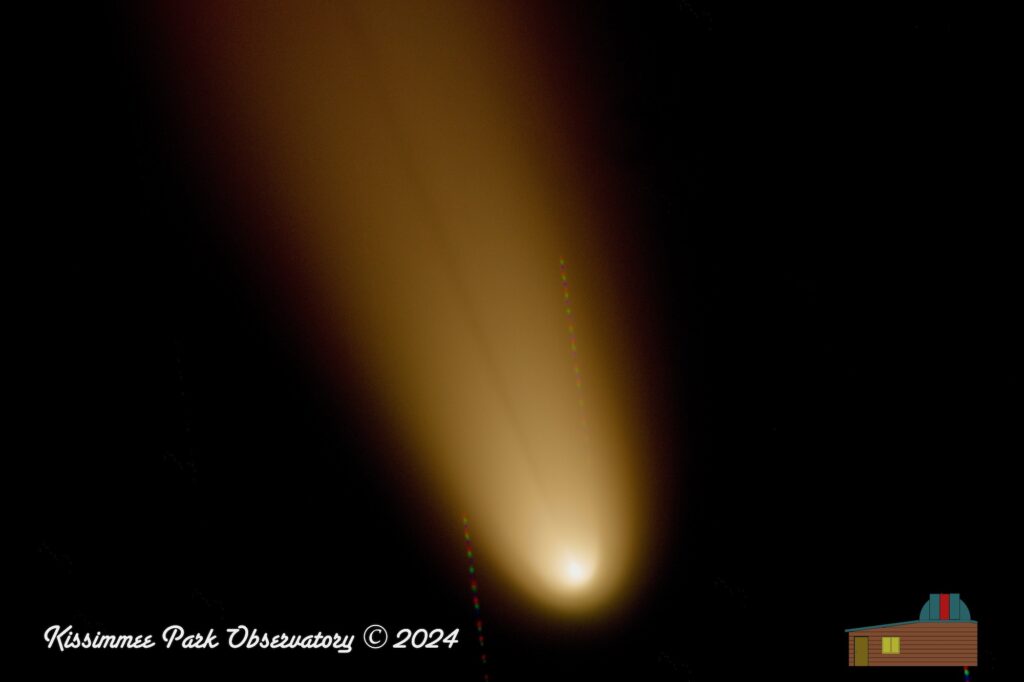
Comet C\2023 A2 captured through the 12″ Ritchey Chretien Astrograph at KPO on October 14th, 2024. 18 minutes total integration time.
Comet C/2023 A2 Tsuchinshan-ATLAS: A Cosmic Odyssey in the Making
In the ever-expanding universe, where celestial bodies move in a silent dance, comets often steal the show with their dramatic appearances. Comet C/2023 A2 Tsuchinshan-ATLAS is the latest protagonist in this cosmic ballet, capturing the attention of astronomers and skywatchers worldwide. This comet, with its intriguing name, tells a story of discovery, anticipation, and scientific wonder.
The Tale of Discovery
Comet C/2023 A2, commonly referred to as Tsuchinshan-ATLAS, was discovered in early 2023. Its name combines two significant points of origin: “Tsuchinshan,” referring to its initial spotting by the Purple Mountain Observatory in China, and “ATLAS,” for the Asteroid Terrestrial-impact Last Alert System, which also detected it independently. This dual discovery highlights the collaborative nature of modern astronomy.
A Journey Through the Solar System
Comets are often described as “dirty snowballs” or “icy conglomerates,” composed of water ice, dust, and frozen gases. Here’s what Comet C/2023 A2 Tsuchinshan-ATLAS’s journey entails:
- Origin: Likely from the Oort Cloud, a spherical shell of icy objects on the outskirts of our solar system, which occasionally sends comets towards the inner solar system due to gravitational perturbations.
- Orbit: Its orbit is highly elliptical, meaning it travels from the far reaches of the solar system to close proximity with the Sun, a journey that might take thousands or even millions of years.
- Perihelion: The comet’s closest approach to the Sun, or perihelion, was anticipated to occur in late 2023 or early 2024, depending on its exact trajectory. This event often causes comets to become more visible as the Sun’s heat vaporizes the ice, creating a glowing coma and tail.
Scientific Fascination
Why does Comet C/2023 A2 Tsuchinshan-ATLAS captivate scientists?
- Cometary Composition: By studying this comet, scientists aim to understand more about the materials present during the formation of our solar system. Comets are like time capsules, preserving ancient materials in their icy cores.
- Water and Life: Comets are believed to have delivered water and organic compounds to Earth, potentially seeding life. Analyzing Tsuchinshan-ATLAS could provide further clues to this theory.
- Orbital Mechanics: Its orbit provides data on the gravitational influences within our solar system, offering insights into the unseen dynamics at play in the Oort Cloud and beyond.
Conclusion
Comet C/2023 A2 Tsuchinshan-ATLAS isn’t just a visitor from the distant past of our solar system; it’s a bridge connecting us to the cosmos, a reminder of the dynamic nature of space, and a catalyst for scientific curiosity. As it makes its way through the inner solar system, it leaves behind not just a trail of dust and gas, but also a legacy of knowledge, wonder, and a renewed appreciation for the universe’s mysteries.
Image Info
- Imaged at KPO, Saint Cloud, FL
- Camera : ZWO ASI2600MM Pro
- Scope: Orion 12″ Ritchey Chretien Astrograph
- Mount: iOptron CEM-120
- Red: 12 subframes of 30s = 6 min integration
- Green: 12 subframes of 300s = 6 min integration
- Blue: 12 subframes of 300s = 6 min integration
- Total integration time: 18 minutes
- Captured via ASIAir Pro automation
- Optical tracking via ASIAir automation via the ASI174mm Pro guide camera – tracked on the head of the comet
- Separate channels stacked and RGB integrated in Astro Pixel Processor
- Final processing in Aperture
